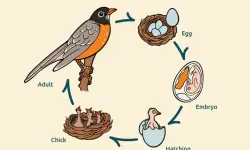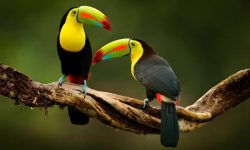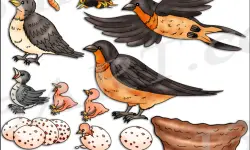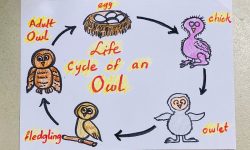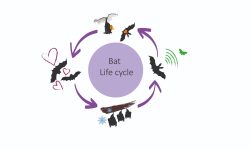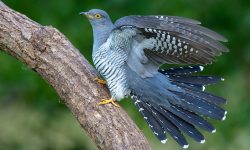Among the remote and wind-swept coasts of western Alaska, one bird stands out with its regal plumage and icy gaze: the Emperor Goose (Anser canagicus). With its silvery-gray body, snow-white head, and contrasting black throat and legs, this goose truly lives up to its royal name. Native to the Bering Sea region and rarely seen outside of Alaska and parts of eastern Russia, the Emperor Goose is one of North America’s most striking and enigmatic waterfowl species.
Once considered vulnerable due to declining populations, this Arctic dweller is a conservation success story in the making. Yet, it remains dependent on remote, fragile ecosystems and sensitive to climate change, habitat degradation, and hunting pressures. This article explores the Emperor Goose’s appearance, habitat, behavior, diet, reproductive cycle, and ecological role in Alaska’s dynamic environments.
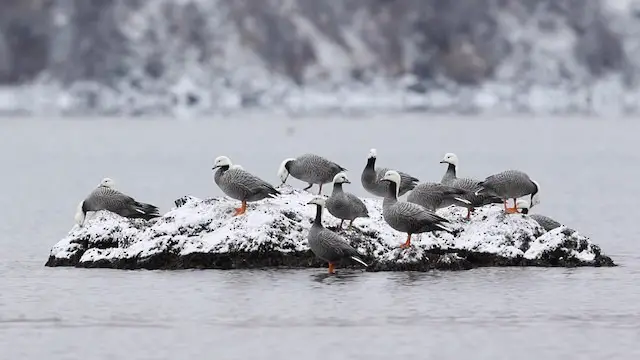
Identification and Physical Features
The Emperor Goose is a medium-sized Arctic goose, measuring approximately 26–28 inches (66–71 cm) in length with a wingspan of about 47 inches (120 cm). Though compact and sturdy in build, it is one of the most visually striking geese in North America, thanks to its unique plumage and coloration.
Its silvery-gray body is finely barred with black and white, creating a texture that resembles chainmail or scales. This gives the goose a distinctive “armored” look, especially at close range.
The head and nape are pure white, but they are often tinged orange or rust-colored—a result of staining from iron-rich mud in the coastal wetlands where the bird forages. This natural coloring adds character and individuality to each bird.
A black throat and short black bill create a sharp contrast with the pale head, enhancing its bold facial pattern. The legs and feet range from dark pink to nearly black, depending on age and season.
Males and females look similar, though males tend to be slightly larger. Juvenile Emperor Geese are duller overall, with dusky gray heads and less distinct barring across the body, making them easily distinguishable from adults in the field.
Habitat and Range
The Emperor Goose is a true coastal specialist, with its entire life cycle closely tied to the remote shorelines of the Bering Sea. Its core breeding range is concentrated in western Alaska, particularly the expansive wetlands of the Yukon-Kuskokwim Delta, which provide ideal nesting and foraging conditions during summer.
The species’ habitat preferences shift with the seasons:
-
Summer (Breeding Season): Emperor Geese nest on the coastal tundra, favoring wet sedge meadows, grassy flats, and areas near brackish ponds and shallow lakes. These open landscapes offer both concealment from predators and abundant plant-based food for adults and goslings.
-
Winter: As temperatures drop, most Emperor Geese move to the Aleutian Islands and southern coastal Alaska, where they inhabit rocky shorelines, tidal mudflats, and estuaries. Here, they feed on marine vegetation, such as eelgrass and algae, often in small, tight-knit flocks.
A small portion of the population migrates westward across the Bering Strait to Chukotka, Russia, representing one of the few transcontinental movements in this species. However, the Emperor Goose remains almost entirely Arctic-bound year-round and is rarely observed inland or in southern regions.
Because of this limited and remote distribution, any sighting outside its typical range—such as in southeastern Alaska, Canada, or the continental U.S.—is considered a rare and exciting event for birders and researchers alike.
Reproductive Biology and Nesting Behavior
The Emperor Goose breeds during the short Arctic summer, typically from late May through early July, with timing closely linked to snowmelt and emerging vegetation. Like many Arctic-nesting geese, the species exhibits monogamous pair bonds, often lasting for life. Established pairs return to the same general nesting territories each year.
Nest Site Selection
Females choose elevated sites such as grassy knolls, hummocks, or sedge-covered mounds, which offer good drainage, visibility, and some protection from flooding and ground predators. These sites are usually near brackish ponds or coastal wetlands, ensuring easy access to food and water for both adults and young.
Nest Construction and Egg Laying
The nest is a shallow bowl constructed with plant materials, lined with soft down feathers plucked from the female’s own breast. She lays a clutch of 3 to 6 creamy-white eggs, one per day, and begins full incubation only after the last egg is laid.
Incubation and Parental Roles
Only the female incubates, a process lasting 24 to 26 days. During this time, the male remains nearby, keeping watch for predators such as gulls, foxes, or jaegers. His presence provides an important layer of protection, especially in the open tundra landscape.
Gosling Development
The goslings hatch precocial—covered in down and able to walk, swim, and forage shortly after emerging. While they feed themselves, they stay close to both parents for warmth, guidance, and protection. The family unit remains intact through the summer rearing period and often stays together during fall migration to coastal staging areas.
This high level of parental investment and the use of remote, undisturbed breeding habitat have helped the Emperor Goose persist in Alaska’s challenging Arctic environment.
Feeding Ecology
The Emperor Goose is a predominantly herbivorous species, with a diet closely tied to its coastal and tundra habitats. Unlike geese that forage in upland fields or agricultural areas, Emperor Geese feed almost exclusively in wet, natural environments, making them specialists in low-lying Arctic and sub-Arctic ecosystems.
Seasonal Diet
-
Summer (Breeding Season): While nesting on the tundra, Emperor Geese primarily consume sedge species (e.g., Carex), grasses (e.g., Elymus), and other emergent vegetation found near brackish ponds and marshes.
-
Migration and Wintering: In estuarine and coastal zones, their diet shifts to include green algae, eelgrass (Zostera), and sea lettuce (Ulva), which they forage from mudflats, tidal pools, and shallow coastal waters.
-
Goslings, though mainly herbivorous like adults, may supplement their diet with small invertebrates or mollusks, especially in early development stages, to gain additional protein for rapid growth.
Foraging Behavior
Emperor Geese use a combination of grazing (plucking vegetation while walking on land) and dabbling (feeding at the surface of water by tipping forward) to access food. Their short, robust bills are well-suited for pulling vegetation in dense, wet soils or in shallow water beds.
They tend to forage close to the ground in coastal meadows, mudflats, or salt marshes, rarely venturing into dry uplands or croplands like other goose species. This low-foraging behavior keeps them out of human-dominated landscapes but makes them more vulnerable to habitat disturbance in estuarine zones.
Seasonal Movement and Migration
Unlike many other North American geese that migrate across continents, the Emperor Goose performs a relatively short-range migration, remaining almost entirely within the Bering Sea region year-round. Its movements are tightly linked to seasonal shifts in ice cover, tidal cycles, and the availability of open water for foraging.
Fall Migration
From late September through October, Emperor Geese begin departing their breeding grounds along the Yukon-Kuskokwim Delta and other coastal tundra regions. They move southward to wintering sites on the Aleutian Islands, Kodiak Island, and occasionally the southern Alaska Peninsula. These areas offer ice-free shorelines, abundant marine vegetation, and sheltered bays ideal for overwintering.
Spring Migration
In April and May, as ice begins to retreat and daylight returns to the Arctic, the geese make their way northward, returning to the low tundra breeding areas of western Alaska. They typically follow coastal flyways, stopping to rest and feed in estuaries and tidal lagoons along the way.
Migration Timing and Climate Influence
The timing of both migrations is highly responsive to environmental cues. Sea ice conditions, tidal rhythms, and spring thaw strongly influence when and how quickly Emperor Geese move. In warmer years, they may depart earlier in spring, while in colder or delayed-thaw seasons, migration can be pushed back significantly.
Because their movements are so sensitive to climate variability, tracking Emperor Goose migrations offers valuable insight into ecosystem changes in the rapidly warming Arctic.
Ecological Role and Behavior
The Emperor Goose (Anser canagicus) is a keystone herbivore in the Bering Sea’s coastal ecosystems. Through grazing on sedges, grasses, mosses, and winter algae like eelgrass, it helps regulate plant communities and enhances nutrient cycling by returning organic matter to the soil. These feeding habits support the productivity of salt marshes, tundra, and intertidal zones.
During migration and winter, Emperor Geese form loose, non-aggressive flocks, often foraging together along coastal shorelines. In contrast, breeding season brings increased territoriality, especially among males defending nesting areas.
Nesting is cryptic, with females selecting well-hidden tundra sites to avoid predators such as gulls and Arctic foxes. Nests are lined with down and typically placed in grassy depressions for camouflage.
Vocalizations are low-pitched and harsh, differing from the clear honks of Canada Geese—likely an adaptation to avoid attracting predators in quieter tundra habitats.
Despite their cold, windswept environment, Emperor Geese are exceptionally hardy, capable of nesting in subfreezing conditions. They also show strong site fidelity, often returning to the same breeding grounds year after year, demonstrating both resilience and ecological consistency.
Conservation Status and Threats
Once in serious decline due to overhunting and egg collection, the Emperor Goose has made a notable recovery thanks to strict conservation measures, including hunting restrictions and habitat protection. Today, the species is classified as “Least Concern” by the IUCN, reflecting its improved population status. However, several ongoing threats still pose risks:
-
Climate change is altering the structure and timing of tundra breeding habitats, potentially disrupting nesting success.
-
Oil spills and marine pollution threaten coastal wintering areas, especially in the Aleutians and Bering Sea.
-
Subsistence hunting continues in native Alaskan communities—legal but regulated to ensure minimal impact.
-
Disturbance from ecotourism and aircraft traffic may interfere with breeding or feeding, especially in remote coastal zones.
Since 2017, regulated legal hunting under permit has been reinstated in Alaska, with strict monitoring programs in place to maintain sustainable population levels. Conservation efforts continue to focus on habitat protection, climate resilience, and cooperation with Indigenous communities.
Symbolic and Cultural Significance
Conclusion
The Emperor Goose is more than a bird of remote Arctic coastlines—it is a symbol of wild Alaska. With its striking appearance, specialized habitat, and tightly synchronized life cycle, it stands as a testament to the resilience of nature in extreme environments. While conservation efforts have helped restore its population, ongoing vigilance is essential to protect this remarkable species for future generations.
In the haunting call of the Emperor Goose echoing across the tundra, we are reminded of the wild, untamed beauty of the far north—and our role in preserving it.

